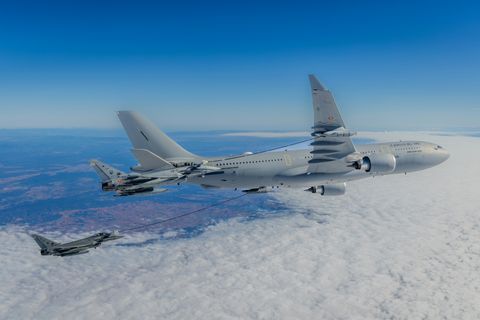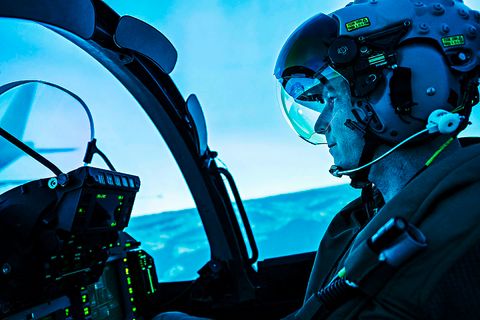The C295 pilots' perspective: evacuating the missing children from the Colombian jungle

In June 2023, a C295 military aircraft safely transported the four children who spent forty days lost in the Colombian jungle to a hospital in Bogotá. The pilots who flew this lifesaving mission tell the story.
“Milagro.”
“Milagro.”
“Milagro.”
“Milagro.”

Colombia’s military forces had agreed on the code to use if they found the four children who were lost in the jungle: “milagro”, which means “miracle”. On 9 June 2023, this code rang out four times on their radios. The siblings had been found!
The aptly named Operation Esperanza (or “Hope”) had achieved what few thought possible. Dehydrated and covered in mosquito bites, but in an “acceptable” medical condition, the four children had – miraculously – survived forty days lost in the middle of the jungle. Weeks earlier, a Cessna 206 plane had crashed between the departments of Caquetá and Guaviare in southern Colombia. The children were the only survivors; tragically, all three adults on board died, including the pilot and the children’s mother.
A combined search effort involving some 200 military personnel and local indigenous communities eventually found the four siblings: Lesly (13 years old) and her brothers Solecni (9), Tien Noriel (5) and baby Cristin Neruman, who turned one during their time in the jungle.

Lesly’s ancestral wisdom: a 13-year-old heroine who kept her siblings alive
“It was a combination of ancestral wisdom and Western wisdom, or between a military technique and a traditional technique. This combination brings hope and joy to life,” Luis Acosta, national coordinator of the Indigenous Guard of the National Indigenous Organisation of Colombia (ONIC), told reporters.
In a jungle where it rains almost every day, Lesly took care of her siblings and kept them alive thanks to the experience she had gained in Araracuara, the village in the heart of the Amazon jungle where the family lived. There she had learned many skills that proved invaluable: how to identify edible mushrooms, how to protect herself from dangerous animals such as snakes and jaguars, and how to follow the sun's rays as they filtered through the trees.
“We must recognise not only her courage but also her leadership because we could say that it was thanks to her that the three little brothers were able to survive by her side, with her care, with her knowledge of the jungle," said Colombia’s Defence Minister, Iván Velásquez.

All mission photos courtesy of the Colombian armed forces
How the aeromedical transfer, using the C295, unfolded
Unable to land on the ground due to the dense jungle, the Colombian military used an Angel UH-60 helicopter to evacuate the children from an altitude of 60 metres in the air, using harnesses and a pulley. Upon their discovery, the Colombian Aerospace Force (FAC) immediately activated a C295 tactical airlifter that was set up in Medical Evacuation (MedEvac) configuration. Pilots Carlos Baena and Édgar Rodríguez were selected to fly the mission.
“We were in training when we got the call. My heart was beating so fast when they told us [the children] were alive and we had to bring them back to Bogotá. I thought I was not going to be selected, it was really emotional,” recalls Rodríguez. “It was shocking at first. I was nervous, but soon I felt a sense of duty and pride; the whole country was waiting for the news that the children had been found. In a way, they represented our heritage and the diversity of the indigenous cultures that make up our country,” adds his colleague, Baena.
In just one and a half hours, the Colombian Air Force carefully modified a C295 aircraft that had just completed a transport mission. Personnel converted it into an air ambulance for patient transfer. Taking into account the clinical condition of the siblings, monitors were adapted for the mission to continuously monitor key vital signs including heart rate, respiration and blood pressure. There were also infusion pumps to administer medicines and fluids, and a defibrillator, just in case. A crew of specialists was also assembled for the flight: two doctors, a paediatrician, a neonatologist, two nurses, a paramedic and a biomedical engineer.
“This quick configuration shows the versatility of the C295,” explains Rodríguez. “It is a very reliable and easy to fly aircraft that plays an important role for our air force. It allows us to reach really remote places where no one else can help, and it works very effectively on narrow and unprepared airstrips.”

The Colombian Aerospace Force has a fleet of six C295 tactical airlifters, which are used for everything from troop and cargo transport and paratrooper training to aerial delivery, MedEvac, and emergency relief missions, such as firefighting support in Patagonia earlier this year.
A nighttime landing on an unpaved runway
The C295 took off from Bogotá and flew to the Jorge Enrique González Torres airport in San José del Guaviare. The nighttime landing had to be performed in an airport without a tower and without lighting. “We arrived about 40 minutes before the moonrise and did a reconnaissance procedure to identify some landmarks for the landing, as there was a river next to the runway whose luminosity could have confused the Night Vision Goggles (NVG),” explains Rodríguez. “It was difficult because normally we take advantage of the moonlight, but this time it was barely visible. Using the NVGs and firing two flares to provide additional artificial light, we were able to identify the runway and land safely on the second attempt,” adds Baena.
Shortly after the C295 landed, the Angel UH-60 helicopter landed on the runway with the minors, who were transferred on stretchers to the C295. “When I saw them alive I felt a deep sense of fulfilment and satisfaction,” remembers Baena. “It was a moment I’ll never forget. For a military pilot, these missions have a special meaning, you see the positive impact we have on society,” concludes Rodríguez.
Once the children were safely on board, the Colombian medical team kept them stable during the flight. The C295 returned to the FAC’s Military Air Transport Command in Bogotá, where four ambulances were waiting to take the siblings to the Central Military Hospital. The children were discharged after a few weeks in hospital.

Formerly a flight instructor on the T-37B, Captain Carlos Baena (left) has been in the Colombian Air Force for 12 years, many of them flying the C295. He is now preparing to become a Major in the FAC. Captain Édgar Rodríguez joined the Air Force in 2004, driven by his vocation to serve and help others. He has flown around 3,800 hours, including 650 hours in the C295.

All mission photos courtesy of Colombian Aerospace Force

All mission photos courtesy of Colombian Aerospace Force



